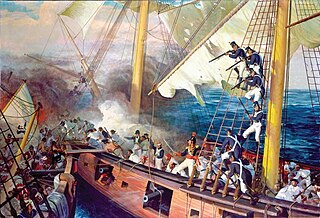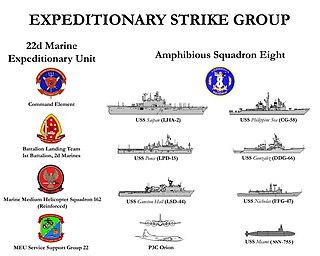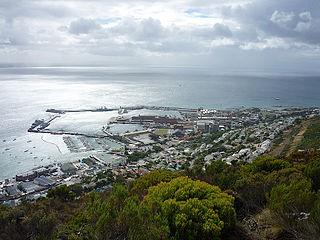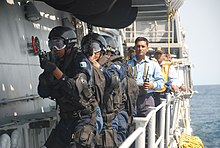
The South African Navy (SA Navy) is the naval warfare branch of the South African National Defence Force.

The United States Naval Special Warfare Command (USNSWC), also known as NAVSPECWARCOM and WARCOM, is the naval component of United States Special Operations Command, the unified command that oversees and conducts the nation's special operations and missions.

Marines, or naval infantry, are soldiers who specialise at operating in littoral zones, both on land and at sea. Historically, the main tasks undertaken by marines have included raiding ashore in support of naval objectives, and the boarding of vessels during combat or capture of prize ships. Marines also help maintain discipline and order aboard the ship. In most countries, marines are an integral part of that state's navy.

The 11th Marine Expeditionary Unit is one of seven Marine Expeditionary Units currently in existence in the United States Marine Corps. The Marine Expeditionary Unit is a Marine Air Ground Task Force with a strength of about 2,200 personnel. The MEU consists of a command element, a reinforced infantry battalion, a composite helicopter squadron and a logistics combat element. The 11th MEU is currently based out of Marine Corps Base Camp Pendleton, California with headquarters in Camp Del Mar.

The Navy Expeditionary Combat Command (NECC) is an echelon III command of the United States Navy, which serves as the single functional command to centrally manage current and future readiness, resources, manning, training and equipping of the United States Navy's 21,000 expeditionary forces who are currently serving in every theater of operation. The NECC was established in January 2006. NECC is a subordinate command of the Navy's Fleet Forces Command.
The structure of the United States Navy consists of four main bodies: the Office of the Secretary of the Navy, the Office of the Chief of Naval Operations, the operating forces, and the Shore Establishment.

In the United States Navy, the expeditionary strike group (ESG) is a coordinated group of surface ships, aircraft, submarines, and other naval assets. In contrast to carrier strike groups (CSGs), which emphasize air power and are led by a supercarrier, ESGs are strongly suited for amphibious warfare and are led by an amphibious assault ship. The ESG concept was introduced in the early 1990s, based on the Naval Expeditionary Task Force. The U.S. Navy fields nine expeditionary strike groups.
The Operational Diving Division is part of the South African Navy's Maritime Reaction Squadron (MRS) that was formed as the Naval Rapid Deployment Force (NRDF) in 2006.

South Africa currently does not have a marine corps, though in the past it did. It was originally set up as a sub-branch of the South African Navy during the apartheid era, with the primary purpose of protecting the country's harbours (1951-1955). Then it was recreated in 1979 during the South African Border War as 1 Marine Brigade with the aim of serving as marine infantry (1979-1990). Today, the SAN Maritime Reaction Squadron is the closest analogue to a marine corps South Africa has.

A Maritime Special Purpose Force (MSPF) is a United States Marine Corps specialized sub-unit of a Marine expeditionary unit. A MSPF is deployed to give the commanders low profile, two-platoon surgical emplacement in the accessible littoral regions. The MSPF provides the enhanced operational capability and precision skills to complement, enable, and execute selected conventional, maritime special operations. They can also perform operations not resident in traditional amphibious raid companies.
The reconnaissance mission within the United States Marine Corps is divided into two distinct but complementary aspects; Marine Division Recon and Force Reconnaissance.

The Naval Infantry Corps are the naval infantry force of the Mexican Navy. The main task of the Infantería de Marina is to guarantee the maritime security of the country's ports and external and internal defense of the country. To accomplish these responsibilities, the corps is trained and equipped to take on any type of operations from sea, air and land.

The Deployable Specialized Forces (DSF) —formerly Deployable Operations Group— are part of the United States Coast Guard that provide highly equipped, trained and organized deployable specialized forces, to the Coast Guard, United States Department of Homeland Security (DHS), United States Department of Defense (DoD) and inter-agency operational and tactical commanders. The command was formerly headquartered in Arlington, Virginia where it was established on 20 July 2007, and was commanded by a captain. It was decommissioned by the Commandant of the Coast Guard, Admiral Robert Papp on 1 October 2013, with units previously assigned to the DOG being split between Coast Guard Pacific and Atlantic Area commands. The units were subsequently reorganized under Deployable Specialized Forces (DSF).
Fleet Command is responsible for the command, operations, readiness, training and force generation of all ships, submarines, aircraft squadrons, diving teams, and shore establishments of the Royal Australian Navy. Fleet Command is headquartered at HMAS Kuttabul in Sydney, and is led by the Commander Australian Fleet (COMAUSFLT), also referred to as Fleet Commander Australia (FCAUST), which is a rear admiral (two-star) appointment.

The Namibian Navy is the maritime warfare branch of the Namibian Defence Force.

The Joint Rapid Reaction Force (JRRF) was a capability concept of the British Armed Forces from 1999 to 2010. It was a pool of specialised units from all three armed services tasked with rapid deployment worldwide at short notice. The force was intended to be capable of mounting operations up to medium scale warfighting. It could be employed nationally, or multinationally under the auspices of NATO, the United Nations or any other coalition.

The Namibian Marines Corps are the marines of Namibia and is part of the Namibian Navy and the Namibian Defence Force.
Fleet Command is the South African Navy's single type command and controls all vessels and units of the South African Navy, besides Naval Headquarters. The commander of Fleet Command is a Rear Admiral and referred to as Flag Officer Fleet (FOF). The post was previously known as Chief of Naval Operations.
The Namibian Special Forces is a special operations command of the Namibian Defence Force responsible for special forces component commands army and marines. The command consists of Namibian Army Commando and Paratrooper, and the Namibian Marine Corps Amphibious Special Operations Unit. The Army Commando specialize in air assault and airborne operations, capture or kill high-value targets, counterterrorism, direct action, hostage rescue, insertion behind enemy lines, executive protection, and special warfare operations, while the Marine Corps Amphibious Special Operations Unit specialize in amphibious warfare, direct action, executive protection, insertion behind enemy lines, maritime counterterrorism and hostage rescue, naval boarding, naval special warfare operations, operating that originate from a river, ocean, swamp and delta, and underwater demolition. The army units receive training assistance from former South African Special Forces (Recces) and the marine corps from the Brazilian Marine Corps. The units regularly participate in Southern African Development Community (SADC) special forces exercises.













